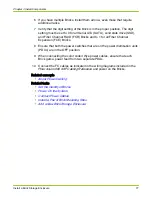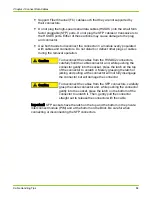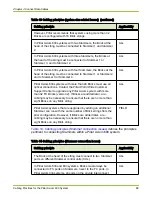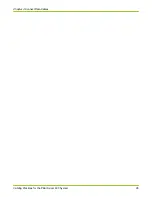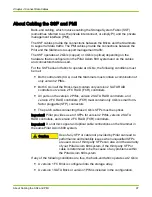
Cable Handling Tips
High speed data optic cables are delicate and can easily be damaged. The cable
plug ends and connectors are also sensitive to dirt and contaminants. Follow
these tips when handling cables.
● Do not bend the cables beyond its minimum bend radius (MBR). MBR is the
tightest bend that the cable can safely tolerate during or after installation.
The MBR for all data cables is two inches (5.1 cm).
● If you do not know the MBR, do not bend the cable to a radius of less than
two inches (5.1 cm). Also, the permanent bend radius of the cable is usually
larger than the temporary bend radius.
● Do not pull any cable or plug with a force exceeding five inches (12.7 cm.).
● Do not use force or rock the connector from side to side or up and down to
remove the connector because this action can damage the socket.
● Do not pull the cables using a mechanical device. If you need to pull a
cable, pull by hand.
● Leave some slack in the cables to allow insertion and removal of connectors.
● String cables with service loops so that it is possible to remove FRUs
without removing the cables.
● Use only soft velcro or equivalent ties for routing or grouping cables. Do not
use hard plastic ties or other hard cinching type of wraps. Using hard plastic
ties can cause performance degradation and cable damage.
● Ensure no damage occurs during cable routing by not leaving cables
exposed in high traffic areas.
● Do not set any hardware components or other objects on top of the cables.
● Do not let the cables get pinched by closed doors or door lock hardware.
● Do not twist the cables.
● Do not wrap the fiber optic cables around your hands, arms, or shoulders,
as this may result in causing sharp bends or a small coiling radius. This can
also impart a twist to the cable upon uncoiling.
● Do not install cables in such a way that they are supported by other cables
or any other SSF cables.
Chapter 4 Connect Data Cables
Cable Handling Tips
83









